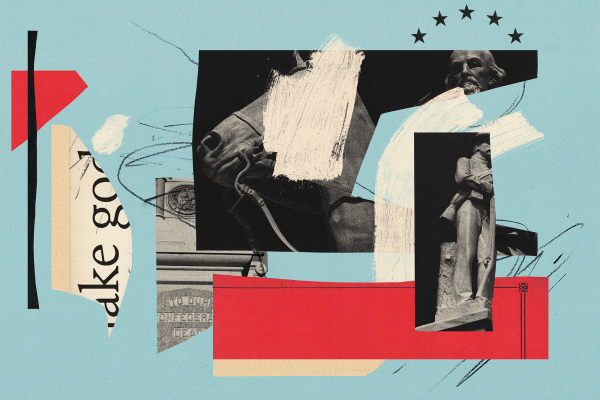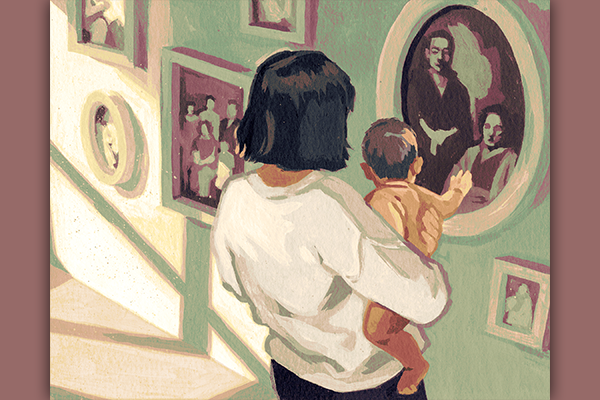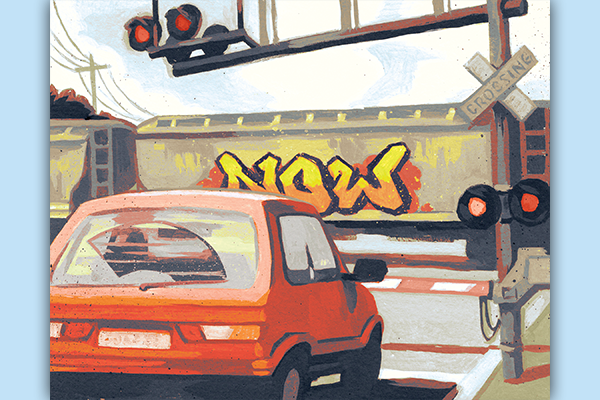EVERY DAY, BEFORE the coronavirus had us sheltering in place, I drove by a Confederate monument on the state capitol grounds near my home in Raleigh, N.C. It was unveiled in 1895 by the granddaughter of Stonewall Jackson, Julia Jackson Christian. Its 75-foot-tall granite column is a fixture of the landscape as people walk past on their way to work or sit on benches beneath its shadow, the shaft marked with the words “to our Confederate dead.”
The monument is strategically placed to assure maximum visibility. Everything about it is purposeful and planned. It makes a claim on the space—claiming the ground, the air, the power of public land with a particular version of history.
“To our confederate dead.” But the question that burns on the stone: Who does “our” represent?
Injustice, idolatry, and repentance
IN 2019, CHARLOTTESVILLE, Va., was still reeling from the August 2017 Unite the Right weekend during which counterprotester Heather Heyer was killed by a white nationalist. Two local Methodist pastors—Rev. Isaac Collins and Rev. Phil Woodson—decided to gather community members for a weekly Bible study aimed at reinterpreting the Confederate monuments that mark Charlottesville’s public space. They called it “Swords into Plowshares: What the Bible says about injustice, idolatry, and repentance.”
The inspiration came from Jalane Schmidt, a public historian and religious studies professor at the University of Virginia in Charlottesville, who has co-led truth-telling tours of the monuments since 2018. Schmidt suggested Collins take up the work of theological interrogation of the history embedded in these monuments and how this history lives on in the churches and Christians in their city.
So, for two months people gathered to study the stories of idolatry in the Bible alongside the history of white supremacy set into the stone and concrete of Charlottesville’s monuments.
After reading about the Bible study in Virginia, I joined with another Raleigh pastor last fall to begin a similar study in our home state of North Carolina. Rev. Chalice Overy, associate pastor of Pullen Memorial Baptist Church, and I had watched what happened in Charlottesville in 2017 with shock and horror. But tensions in our state were also high. In August 2017, protesters in Durham forcibly removed a Confederate statue from the entrance to a downtown building. One year later, after months of student sit-ins, student protesters tore down “Silent Sam,” a statue erected in 1913 by the University of North Carolina and the United Daughters of the Confederacy.
Rev. Overy and I knew it was time for a public conversation with other Christians about the monuments on the capitol grounds in Raleigh. Almost all these monuments are to Confederate soldiers and slave owners. How could our faith inform our understanding of the history built into our public spaces? What stories do they reiterate, which version of history do they center?
Shifting the focus from slavery
OVERY AND I researched the 75-foot-tall monument and five others on the grounds of the capitol, uncovering racism, historical distortion, and re-narration of the past that attempted to secure a flourishing white future while scapegoating black citizens. Each week for six weeks we linked one of the monuments with a story of idolatry from the Hebrew Bible. In discovering the lure, risk, and devastation Israel faced among the “gods of these lands” (2 Kings 18:35), we encountered Southern history that turned memorial stones into idols to a white supremacist god.
The monument “to our Confederate dead,” where we began our Bible studies, was endorsed by the state legislature in 1892, nearly three decades after the end of the Civil War. Over those many years prior there had been no formal push to memorialize the North Carolinian Confederate soldiers who died in the war.
So, what changed? Why was this issue raised a generation later?
Here, history becomes politics. In the early 1890s, factionalism and distrust grew among white farmers who believed that the Democrat-controlled legislature was no longer meeting their interests. An economic downturn provided a window for a shift in power. Soon after, the Southern Democrats called for the construction of the Confederate monument to “our” dead.
The monument created the myth of a common solidarity between white Southerners. It bound them together in suffering a humiliating loss and thousands of casualties during the Civil War. The monument implied that freed black citizens were the cause of whites’ woes. It shifted the focus from slavery, the real cause of the Civil War, to states’ rights. Historians would later call this the “Lost Cause” narration.
More than 100 years later, we stood on the spot where Col. Alfred Moore Waddell, famed for his oration on the Democratic campaign trail promoting the party’s single platform of “white supremacy,” addressed the crowd at the monument’s unveiling. I read his statement aloud. We could hear the whitewashing of history:
[Slavery] was an institution, guaranteed and protected by the Constitution, as exclusively within the control of the State, and when the equality and reserved rights of the States were attacked by interference with it, there was just ground to believe that other preserved and guaranteed rights would be assailed, and the equality of the States destroyed.
Worshiping the idols of their captors
THE DEMOCRATS WERE briefly out of power in the mid-1890s, but in 1898 they regained control of the North Carolina state legislature. Over the next 10 years they divided the state on racial lines, disenfranchised black voters, and enacted horrifying and repressive Jim and Jane Crow laws.
Overy opened her Bible to Exodus. She read aloud the story of a people left at the foot of a mountain. Moses, the one they trusted, the one who led them out of slavery in Egypt, had disappeared above to the cloudy peak. The people left behind were afraid. What would become of them? What if Moses didn’t return?
They turned to Aaron and directed him, “Come, make gods for us, who shall go before us.” They needed a god they could see. They knew what gods should look like. They erected a golden calf, one with striking resemblance to the Egyptian bull god, Apis, homage to the gods of their enslavers.
The golden calf offered them a sense of identity—at the cost of warping their view of the past and distorting their future. The gods of Egypt were woven into the Hebrews’ enslavement and oppression. Now, freed by the hand of the living God, the people returned to worshiping the idols of their captors.
Standing before this monument to white supremacy, to “our” confederate dead, I recalled God’s first commandment: “You shall have no other gods before me.”
It’s not obvious why God would command this. Who could possibly get hurt by worshiping a silly, false god?
But here, before us in this circle, we saw what happens when a people worship the terror of their past. We understood what happens when we put our assurance in a distorted version of history. History acts upon us—and monuments, which become our gods, are its most indelible form.
What monuments hide
OVER THE WEEKS, Overy and I met people who told us they were surprised at what they’d learned in our Bible study. The history of these stones had been hidden. We had not been told these stories in school. We walked by these monuments, these idols, and they became part of the scenery. A monument to white women who lost sons in battle, even as those sons were raised by enslaved women of African descent. A monument to the so-called “education governor,” Charles B. Aycock, who used his power to create a caste system of segregated schools, assuring that the children of freed slaves would have subpar opportunities for advancement.
In each Bible study we would trace the thread between the disenfranchisement of black citizens in the 1890s to North Carolina’s current state politics. We are the inheritors of these gods of white supremacy who mark our public spaces. Racialized gerrymandering, constitutional amendments to require voter identification, erosion of public education—all of this is bound up in how history is told. It towered above us in the monuments at our state capitol, prominent for all to see.
Most visitors to North Carolina’s state capitol are schoolchildren. The monuments are used to teach Confederate valor to our children, generation after generation. We orient ourselves around Confederate monuments that tell a distorted “history” of a fictive white struggle for state autonomy. Confederate monuments inhibit the possibility of mourning and repenting that can only follow truth-telling.
Learning to repent
AS CHRISTIANS, OVERY and I knew that we needed a different story, a redemptive story. We needed to learn how to tell the truth, rooted in the stories of God’s people, a people formed to resist the idols of the land.
After Moses returned from the mountain, after he found the people worshiping the god of their enslavers, he broke the golden calf to pieces. He burned the wrecked statue, ground the ashes into a fine powder, then sprinkled them into water. He gave this water to the Israelites to drink.
As part of each Bible study, we asked people to reflect in small groups on the interplay between biblical idolatry and the idolatry of white supremacy preserved in our Confederate monuments. A Lutheran pastor shared with a member from St. Ambrose, one of Raleigh’s historic black Episcopal churches. A man on his lunch break spoke with a lawyer and a Mennonite pediatrician. Passersby on vacation from the Virgin Islands decided to join in.
Each week we would take history into our bodies, drink it in, let it work through us. We made space to encounter a past that is never past to our politics today. Each week we would drink deeply.
Over time we witnessed the unfolding history of the Israelites as they were tempted by idols. We learned the persistence of truth-telling and repentance. We saw them mock the prophets of Baal and pen bruising words for those who sent their children off to be sacrificed to the god Molech. We read these stories in the shadow of the idols erected by our ancestors. We learned to repent.
At the close of each study we formed a circle around the object of our research and history. Together we prayed a litany based on the words of the South African pastor Alan Paton:
Let us not be afraid to the defend the weak because of the anger of the strong. Help us not be afraid to defend the poor because of the anger of the rich. Show us where love, hope, and faith are needed, and use us to bring them to places of struggle. Open our eyes and ears so that we may do the work given us to do.
In North Carolina, the GOP-led state legislature has eliminated the rights of local municipalities to control their own futures, including the removal of Confederate monuments.
We also know that “grinding idols into dust” begins here.

Got something to say about what you're reading? We value your feedback!






